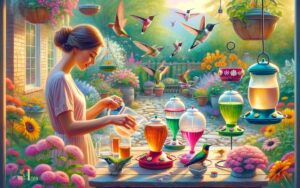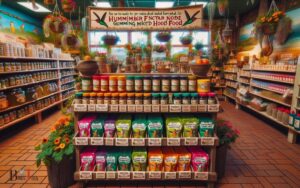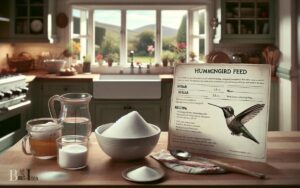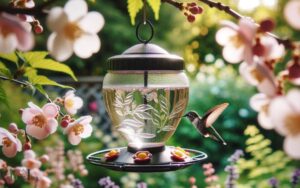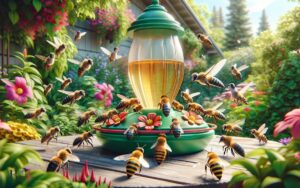What Is the Best Food to Attract Hummingbirds? Discover!
To attract hummingbirds, the best food to offer is a homemade nectar solution made of one part white sugar to four parts water, boiled and cooled.
This simple mixture mimics the natural nectar found in flowers which hummingbirds feed on. Avoid adding red dye or any other additives as they are unnecessary and could be harmful to the birds.
Hummingbirds are primarily attracted to flower nectar for its sweetness and energy value. A homemade nectar solution is the closest substitute to natural flower nectar and is easy to prepare.
Recipe for Homemade Nectar:
Commercial hummingbird food is available but it’s vital to choose products without dyes or preservatives.
In addition to nectar, planting native flowering plants can provide a natural food source and attract hummingbirds to your garden.
Create a hummingbird haven with bright flowers and a reliable source of fresh nectar to enjoy the delightful sight of these vibrant birds.
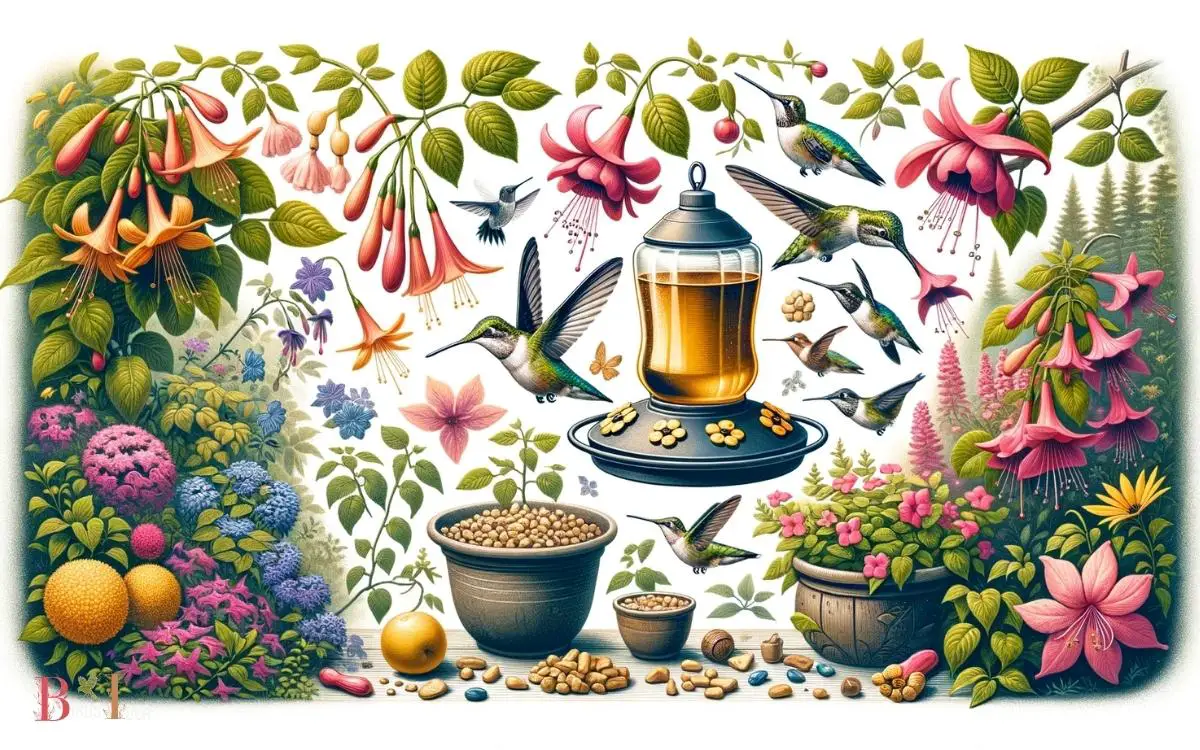
Key Takeaway
Understanding Hummingbird Diet
Understanding the intricacies of the hummingbird diet is crucial for attracting these delicate creatures to your garden.
Hummingbirds primarily feed on nectar from flowers, but they also require insects and spiders for essential proteins and nutrients.
Incorporating a variety of nectar-producing flowers such as trumpet vine, bee balm, and salvia will provide a natural food source for these beautiful birds.
Additionally, offering a protein source like small insects or spiders will supplement their diet and support their nutritional needs, especially during nesting and breeding seasons.
Providing a diverse and abundant food supply is vital for attracting and maintaining hummingbirds in your garden.
By understanding and catering to their dietary requirements, you can create a welcoming environment that supports the well-being of these fascinating creatures.
Different Types of Foods That Attract Hummingbird
Hummingbirds are attracted to a variety of foods, primarily nectar from flowers, which provides them with the energy they need.
If you want to attract hummingbirds to your garden or feeding station, you can provide food in the form of nectar and other supplementary items.
Here are some of the best types of foods to attract hummingbirds:
Nectar:
- Prepare a simple sugar solution by mixing four parts water with one part white granulated sugar. Avoid using honey, as it can promote the growth of harmful fungi.
- Boil the water to dissolve the sugar and let it cool before filling hummingbird feeders.
- Red-colored feeders are more attractive to hummingbirds.
Sugar Solution:
- A simple sugar solution, made by mixing four parts water with one part white granulated sugar, is the best food for hummingbirds.
- Use hummingbird feeders to offer the sugar solution. Ensure they are kept clean and free of mold.
Commercial Hummingbird Food:
- Commercial hummingbird food is a convenient and nutritionally balanced option, providing essential energy for hummingbirds.
- It ensures a reliable food source with minimal effort for attracting and supporting these captivating birds.
Flowering Plants:
- Plant a variety of nectar-rich flowers in your garden, preferably in bright colors like red, orange, and pink. Some examples include bee balm, salvia, fuchsia, and trumpet vine.
- Choose flowers that bloom at different times to provide a continuous food source.
Insects:
Hummingbirds also consume small insects and spiders for protein. By minimizing pesticide use in your garden, you can attract insects and provide an additional food source for hummingbirds.
Fruits:
While nectar is their primary food, hummingbirds may also feed on the juice of overripe fruits. You can set out slices of ripe fruit, such as melons or bananas.
Misting or Dripping Water:
Hummingbirds love to bathe and may be attracted to misting or dripping water. Consider setting up a mister or a shallow bird bath with a gentle drip for them to enjoy.
Tree Sap:
- In their natural habitat, hummingbirds may feed on tree sap. While this is less practical for attracting them in a garden, it’s good to be aware of their varied diet.
Remember to clean feeders regularly to prevent the growth of mold and bacteria, and change the nectar every 3-5 days, or more frequently in hot weather.
Providing a variety of food sources and maintaining a clean and safe environment will help attract and keep hummingbirds in your area.
Homemade Nectar Recipes
To attract hummingbirds to your garden, you can prepare homemade nectar using a simple recipe that mimics the natural nectar found in flowers.
Here’s a quick and easy recipe to make your own hummingbird nectar:
Ingredients:
- 1 part white granulated sugar
- 4 parts water
Instructions:
- Boil the water.
- Stir in the sugar until completely dissolved.
- Let the mixture cool before filling your hummingbird feeder.
Transitioning into the subsequent section about ‘commercial hummingbird food options’, it is important to consider the convenience and nutritional value of these alternatives.
Avoiding Harmful Additives
To ensure the health and well-being of hummingbirds, it is crucial to avoid harmful additives in their food sources.
When preparing nectar for hummingbirds, it’s important to use only plain white granulated sugar and water in a ratio of 1:4.
Avoid using honey, brown sugar, artificial sweeteners, fruit juices, or food coloring, as these additives can be detrimental to the hummingbirds’ health.
Honey can promote the growth of fungus which is harmful to hummingbirds, while artificial sweeteners lack the necessary energy hummingbirds require. Food coloring, often used to attract hummingbirds, can be toxic to them.
Additionally, brown sugar and fruit juices can ferment rapidly, leading to bacterial growth that can cause illness in these delicate creatures.
By sticking to the simple, natural nectar recipe, you can help ensure the well-being of the hummingbirds you seek to serve.
Transitioning into the subsequent section about ‘commercial hummingbird food options’, it is important to consider the convenience and nutritional value of these alternatives.
Commercial Hummingbird Food Options
When considering commercial hummingbird food options, it’s important to weigh the benefits and drawbacks of sugar water versus nectar-based products.
Additionally, the presence of artificial colorings and preservatives in some commercial options may raise concerns for health and environmental impact.
Natural ingredients should also be taken into consideration when evaluating the overall quality and appeal of commercial hummingbird food.
Sugar Water Vs. Nectar
Commercial hummingbird food options include sugar water and nectar, which provide essential nutrients for attracting and nourishing these tiny birds.
When considering sugar water, it is important to use a solution of four parts water to one part sugar, as this closely mimics the natural nectar found in flowers.
On the other hand, nectar is a pre-made hummingbird food option that can be purchased in stores. It is convenient and ready to use, saving time and effort.
Additionally, nectar often contains added vitamins and minerals to further support the hummingbirds’ health.
Both options are effective in attracting hummingbirds, and the choice between sugar water and nectar ultimately depends on convenience, time, and personal preference.
Artificial Colorings and Preservatives
Discussing the use of artificial colorings and preservatives in commercial hummingbird food options is essential for understanding their potential impact on the health and well-being of these delicate birds.
Many commercial hummingbird food products contain artificial colorings to attract birds, but these additives offer no nutritional value and may even be harmful to hummingbirds.
Additionally, preservatives are often used to extend the shelf life of these products, but they can pose health risks to hummingbirds, as their delicate systems may not tolerate these chemicals well.
When choosing commercial hummingbird food, it is important to carefully read the ingredients list and opt for products that are free from artificial colorings and preservatives. P
Prioritizing the health and safety of hummingbirds by serving them natural, additive-free food is crucial in attracting and supporting these vibrant and cherished creatures.
Consideration for Natural Ingredients
Considering the potential impact of artificial colorings and preservatives on hummingbird health, natural ingredients in commercial hummingbird food options are crucial for supporting the well-being of these delicate birds.
When selecting commercial hummingbird food, look for options that contain:
- Pure cane sugar, to provide a natural source of energy for the hummingbirds.
- Filtered water, ensuring that the hummingbirds are consuming clean and safe hydration.
- Natural fruit extracts, such as those from flowers like hibiscus or honeysuckle, to mimic the nectar of their preferred flowers.
These natural ingredients not only offer essential nutrients and energy but also minimize the risk of harmful additives.
Transitioning from artificial to natural ingredients in commercial hummingbird food can significantly contribute to the overall health and vitality of these remarkable birds.
Moving forward, let’s explore the next essential aspect – ‘planting hummingbird-friendly flowers’.
Planting Hummingbird-Friendly Flowers
Planting hummingbird-friendly flowers enhances the attractiveness of a garden to these tiny, nectar-seeking birds.
By incorporating a variety of flowers that produce an abundance of nectar, you can create an inviting environment for hummingbirds.
Below are some examples of flowers that are particularly appealing to hummingbirds:
| Flower Type | Color | Bloom Time |
|---|---|---|
| Trumpet Vine | Orange | Summer-Fall |
| Bee Balm | Red, Pink, Purple | Summer-Fall |
| Salvia | Red, Pink, Purple | Summer-Fall |
| Penstemon | Red, Pink, Purple | Spring-Summer |
These flowers not only provide a vital food source for hummingbirds but also add vibrant colors and beauty to your garden.
The next section will delve into the benefits of using hummingbird feeders to further attract and support these delightful birds.
Using Hummingbird Feeders
Hummingbird feeders provide a reliable and accessible source of nectar, supplementing the natural floral offerings in attracting and supporting these agile birds in your garden.
When using hummingbird feeders, consider the following:
- Placement: Hang the feeder near flowers or shrubs to mimic their natural feeding environment.
- Visual Appeal: Opt for feeders with vibrant red parts to catch the birds’ attention.
- Maintenance: Regularly clean and refill the feeders with fresh nectar to ensure the birds have a healthy food source.
- Protection: Utilize feeders with bee guards and ant moats to safeguard the nectar from unwanted pests.
How Can I Use the Best Food to Attract Hummingbirds to Observe Their Adaptations?
Using the best hummingbird food acquisition adaptation can attract these agile birds for observation. By offering a blend of natural nectar and homemade solutions, we can entice them to visit our gardens. Understanding their adaptation to acquiring food helps in creating an environment that meets their needs, enhancing the chances of experiencing their remarkable adaptations firsthand.
Tips for Attracting Hummingbirds
When attracting hummingbirds, it is essential to provide a safe and nutritious environment for these delicate creatures, including using the appropriate nectar recipe to avoid harmful additives.
To attract hummingbirds effectively, consider the following tips:
- Plant native flowers and flowering shrubs in your garden to provide a natural food source for hummingbirds.
- Include bright, tubular flowers such as trumpet vine, bee balm, and salvia to attract hummingbirds with their vibrant colors and nectar.
- Place multiple feeders in different locations around your yard to accommodate territorial behavior and prevent overcrowding at a single feeder.
Conclusion
Attracting hummingbirds can be achieved through understanding their diet, offering homemade nectar or using commercial food options, planting hummingbird-friendly flowers, and using feeders.
It is important to avoid harmful additives and to create a welcoming environment for hummingbirds.
For example, a homeowner in Arizona successfully attracted hummingbirds by planting a variety of native flowers and regularly maintaining clean feeders, resulting in a thriving population of hummingbirds in their backyard.

